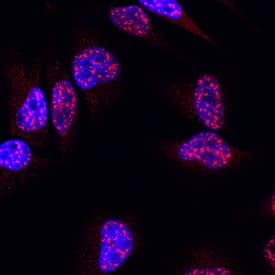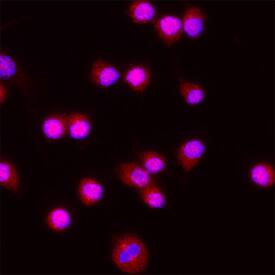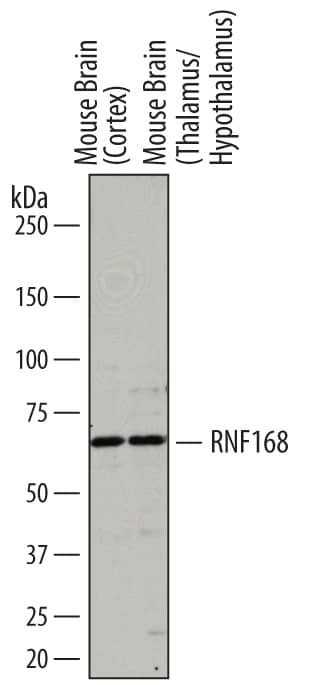Human/Mouse RNF168 Antibody
R&D Systems, part of Bio-Techne | Catalog # AF7217

Key Product Details
Species Reactivity
Validated:
Cited:
Applications
Validated:
Cited:
Label
Antibody Source
Product Specifications
Immunogen
Asn423-Arg565
Accession # Q80XJ2
Specificity
Clonality
Host
Isotype
Scientific Data Images for Human/Mouse RNF168 Antibody
Detection of Mouse RNF168 by Western Blot.
Western blot shows lysates of mouse brain (cortex) tissue and mouse brain (thalamus/hypothalamus) tissue. PVDF membrane was probed with 0.5 µg/mL of Sheep Anti-Mouse RNF168 Antigen Affinity-purified Polyclonal Antibody (Catalog # AF7217) followed by HRP-conjugated Anti-Sheep IgG Secondary Antibody (Catalog # HAF016). A specific band was detected for RNF168 at approximately 65 kDa (as indicated). This experiment was conducted under reducing conditions and using Immunoblot Buffer Group 1.RNF168 in HeLa Human Cell Line.
RNF168 was detected in immersion fixed HeLa human cervical epithelial carcinoma cell line using Sheep Anti-Mouse RNF168 Antigen Affinity-purified Polyclonal Antibody (Catalog # AF7217) at 10 µg/mL for 3 hours at room temperature. Cells were stained using the NorthernLights™ 557-conjugated Anti-Sheep IgG Secondary Antibody (red; NL010) and counterstained with DAPI (blue). View our protocol for Fluorescent ICC Staining of Cells on Coverslips.Detection of RNF168 in RAW 264.7 Mouse Monocyte/Macrophage Cell Line.
RNF168 was detected in immersion fixed RAW 264.7 Mouse Monocyte/Macrophage Cell Line using Sheep Anti-Human/Mouse RNF168 Antigen Affinity-purified Polyclonal Antibody (Catalog # AF7217) at 5 µg/mL for 3 hours at room temperature. Cells were stained using the NorthernLights™ 557-conjugated Anti-Sheep IgG Secondary Antibody (red; Catalog # NL010) and counterstained with DAPI (blue). Specific staining was localized to nuclei and cytoplasm. View our protocol for Fluorescent ICC Staining of Cells on Coverslips.Applications for Human/Mouse RNF168 Antibody
Immunocytochemistry
Western Blot
Sample: Mouse brain (cortex) tissue and mouse brain (thalamus/hypothalamus) tissue
Formulation, Preparation, and Storage
Purification
Reconstitution
Formulation
Shipping
Stability & Storage
- 12 months from date of receipt, -20 to -70 °C as supplied.
- 1 month, 2 to 8 °C under sterile conditions after reconstitution.
- 6 months, -20 to -70 °C under sterile conditions after reconstitution.
Background: RNF168
RNF168 (RING [really interesting new gene] finger protein 168; also E3 ubiquitin-protein ligase RNF168) is a 65 kDa (predicted) member of the RNF168 family of proteins. It is ubiquitously expressed, and serves as an E3 ubiquitin ligase. Following DNA damage, RNF8 is recruited to DNA double-strand breaks by phosphoMDC1. Here, RNF8 first monoubiquitinates histone H2A, and then promotes RNF168 recruitment. RNF168 now acts as an additional ubiquitinase, promoting multiple ubiquitinations plus the recruitment of 53BP1, a scaffold protein that holds DNA damage response elements. Mouse RNF168 is 565 amino acids (aa) in length. It contains one Zn-finger/RING domain (aa 16-55) plus two ubiquitin-interacting MIU motifs (aa 168-191 and 438-461). There are three potential Ser/Thr phosphorylation sites. Two potential isoform variants are reported. One shows an alternative start site at Met20, while a second possesses a two aa extension at the N-terminus coupled to a 13 aa substitution for aa 343-565. Over aa 423-565, mouse RNF168 shares 79% and 65.5% aa sequence identity with rat and human RNF168, respectively. Over aa 423-466, mouse RNF168 shares 98% aa sequence identity with human RNF168.
Long Name
Alternate Names
Gene Symbol
UniProt
Additional RNF168 Products
Product Documents for Human/Mouse RNF168 Antibody
Product Specific Notices for Human/Mouse RNF168 Antibody
For research use only


